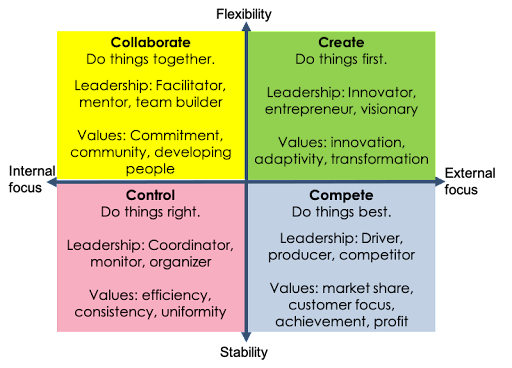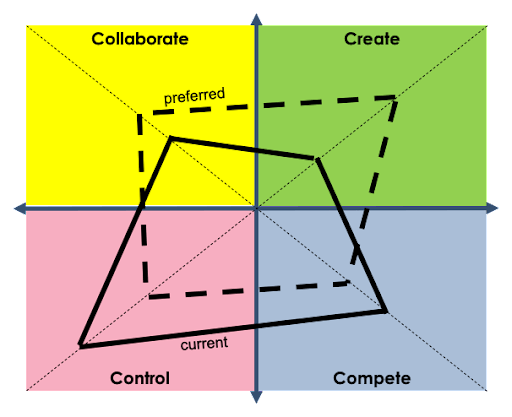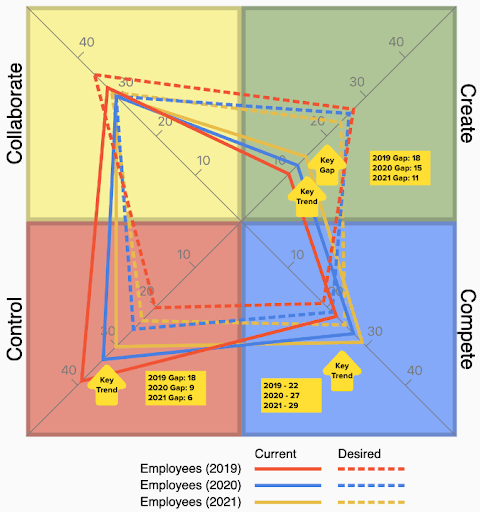Cultivating Culture to Enable Business Agility
"Culture eats strategy for breakfast." — Peter Drucker
Business agility can be achieved and sustained only if the organization’s
culture supports agility. However, understanding, relating to, and cultivating culture is a challenge for most leaders. This blog hopes to simplify, quantify and make culture more accessible to leaders. Let’s start with a working definition of this abstract concept of ‘culture’. Here is a definition we find useful:
“Culture is the set of behaviors that are accepted and expected.” -- Andrea Tomasini
We also find it useful to have a language and a model to visualize culture. The Competing Values Framework(1) (CVF) offers a useful framework that has been extensively researched and validated over two dozen years by thousands of organizations across the globe. The CVF is a two dimensional set of competing values defining four quadrants, as shown in Figure 1. The vertical dimension is flexibility versus stability, and the horizontal dimension is internal focus (orientation) versus external focus.

Each quadrant defines a set of values and leadership traits aligned with them. Culture is a complex phenomenon, so in reality, every organization exhibits a blend of the four quadrants, as well as a gap between the perceived culture and a desired culture. Figure 2 illustrates how, though a series of questions or interviews, leaders can begin to visualize their current and desired culture.

Research by Cameron and Quinn indicates that the most aligned, effective, and healthy organizations demonstrate a relatively balanced mix of the four quadrants: not a perfectly even mix, but not too far out of balance. An organization is only as strong as its weakest quadrant. Furthermore, the most effective organizations have tighter alignment between their current perceived culture and their desired culture.
Shaping Culture
As shown above, CVF provides a simple framework for leaders to understand their culture and make deliberate decisions about how they want to shape the culture. However, it does not dictate one particular culture or direction — that is left to the discernment of leadership based on a number of factors including industry regulations, risk tolerance, market competition, leadership preferences, and more. However, once a directional values decision is made, leadership teams have four levers at their disposal to influence the culture.
- Policies
- Structures
- Metrics
- Leadership Behaviors
Due to the complexity of culture, it’s not easy to predict the effect any of these actions will have, and what side effects or unintended consequences might result. Any action intended to shape the culture should therefore be treated as an experiment, which can be summarized in this form:
If we do [x], we believe it will result in [y]. We can know if this is happening if we observe or measure [z].
An example of a culture-shaping policy experiment
Imagine an organization desiring more creative values as shown in Figure 2. An example of an experimental policy might be to institute a semi-annual ‘hackathon’, where delivery teams are provided a day to a week to freely choose, team-up, and deeply focus on their own creative projects to improve the organization and/or value to their customers.
Experiment statement:
“If we run a semi-annual hackathon, we believe we will foster more innovative ideas from our employees. We can know if this is happening if we observe at least two team-inspired changes or features deployed and embraced by 30% of users within 6 months of delivery.”
Culture and Leadership
“Leadership and culture are two sides of the same coin.” – Edward Schein
While policy, structure and metrics all shape culture, leadership behaviors may carry more weight than all those factors combined. Leaders’ actions demonstrate what is tolerated, expected, and rewarded.
Shaping the culture in a particular direction (or directions) means shifting leadership behaviors accordingly. The CVF describes leadership traits aligned with each quadrant, as emphasized in Figure 3.

Many leaders have a dominant or default leadership style, and organizations influence leadership style through structures, policies and measures. To shift the culture, leaders must first be aware of these preferences and biases, and deliberately experiment with and practice new leadership behaviors. This does not mean abandoning one leadership style and replacing it with another; rather, it means seeking a healthy tension between disparate traits and integrating them.
Continuing the situation from above shaping from control to more create values, as shown previously in Figure 2. The authors of Competing Values Leadership(2) describe a leadership behavior that integrates the leadership traits of both the Control and Create quadrants: they call this behavior “Practical Vision.”
- Control-oriented leaders emphasize reason, practicality, and logic. They tend to focus internally and short-term on issues with higher certainty.
- On the other hand, Create-oriented leaders emphasize vision, hope, and transformation. They focus externally and look farther into the future.
A more balanced leader integrates aspects of both styles. The leader is both practical and visionary. Leaders should seek to integrate values from both quadrants as opposed to swinging
the pendulum from one to the other by way of a practical vision, safe experiments, disciplined innovation, and more.
A real-world example of deliberate culture shift through leadership
The organization in this example shared the directional shift we have been exploring — a desired shift towards the creative quadrant and away from the control quadrant. Surveys over a three-year period visualized the perceived culture, desired culture and the actual shifts over time by leaders. Figure 4 below shows the results of employee culture surveys from 2019 through 2021. It shows a clear trend of reducing control behaviors and increasing creative behaviors by leaders. This example also demonstrates that culture change takes time and sustained effort, and that it can be measured.

Conclusion
Cultivating and shaping the organization culture is critical to achieving sustainable business agility. Leaders must understand their organization’s culture and deliberately run experiments to shift culture in the desired direction. Leadership behaviors play a key role in determining culture, so leaders themselves must adapt their behaviors to align with the desired culture. Leaders must also be patient and persistent, as culture change won’t come easy or quickly.
Questions to explore
- What is your organization’s present value set related to the Competing Values Framework? Take our quick assessment to find out.
- To increase your organization’s business agility, what directions do you need to shift?
- As a leader, which of your beliefs, biases, thoughts or behaviors might contribute to impeding such a shift?
References
- Cameron, Kim S. & Robert E. Quinn. Diagnosing and Changing Organizational Culture Based on the Competing Values Framework, Third Edition. Jossey-Bass 2011
- Cameron, Kim S. et. al. Competing Values Leadership, Second Edition. Edward Elgar Publishing Limited. 2014






